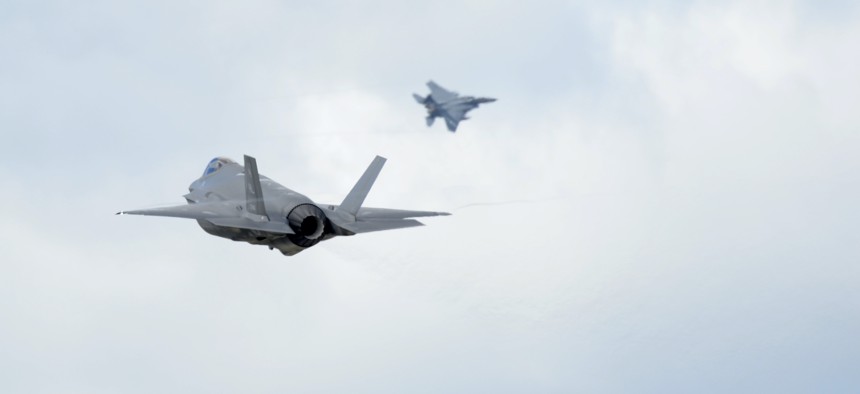
An F-35A Lightning II from the 34th Fighter Squadron at Hill Air Force Base, Utah, takes off at Royal Air Force Lakenheath, England, April 25, 2019.. U.S. Air Force / Staff Sgt. Emerson Nuñez
Engine Deals Reveal US Wants to Maintain Three Warplane Makers
But the multibillion-dollar deals raise questions about just how far along the Next Generation Air Dominance program is.
The Air Force plans to invest billions of dollars to develop new combat fighters—and the military engines to power them—over the next decade.
The plan shows Air Force leaders’ desire to keep its three large airplane makers—Lockheed Martin, Boeing, and Northrop Grumman—as well as engine makers General Electric and Pratt & Whitney, viable to build aircraft for years to come.
The five companies on Friday received identical contracts “for technology maturation and risk reduction activities through design, analysis, rig testing, prototype engine testing, and weapon system integration.” The deals are part of the “execution of the prototype phase of the Next Generation Adaptive Propulsion program and [are] focused on delivering capability enabling propulsion systems for future air dominance platforms and digitally transforming the propulsion industrial base.”
The Next Generation Adaptive Propulsion effort is supposed to produce an engine for what the Air Force calls the Next Generation Air Dominance, or NGAD: a new fighter jet that has been secretly under development since at least the latter part of the Obama administration. Air Force leaders in September 2020 revealed that they had secretly built and flown a NGAD prototype.
Because the planes were designed using digital computer technology, “We've got significant design maturity in our earlier stage then would traditionally be the case,” Andrew Hunter, the head of Air Force acquisition, said during a June briefing.
But Friday’s contracts, which could pay each company up to $975 million between now and 2032, also raise questions about the maturity of the plane, or planes, that have already flown.
Air Force leaders have refused to name the company or companies behind the prototype, citing the program’s top secret classification.
“Either they've made a decision [on a contractor’s design], or it's not that advanced or, incredibly, there are three players with an advanced state of maturity,” said Richard Aboulafia, managing director for AeroDynamic Advisory, an aerospace consulting firm. “Two of these must be lies—one of them must be the truth.”
The Pentagon in 1996 chose Lockheed Martin and Boeing to build proptypes for what would eventually become the F-35. It awarded Lockheed the F-35 contract in October 2001. The first F-35 didn’t fly until 2006, and the first plane didn’t see combat until 2018.
In late spring of this year, Air Force Secretary Frank Kendall said NGAD was in the engineering and manufacturing development phase of acquisition, which is Pentagon-speak that means the plane was still being designed and was not ready for mass production.
In 2020, Will Roper, then head of Air Force acquisition, characterized the prototype as a “full-scale flight demonstrator [that] has already flown in the physical world.” He said the aircraft has “broken a lot of records in the doing.”
As things stand now, Lockheed Martin has the only active stealth-fighter production line, and Northrop Grumman has the only stealth-bomber production line, which its CEO has characterized as a sixth-generation military aircraft. Boeing makes new versions of the F-15 and F/A-18, plus a new pilot training jet.
In 2019, a senior defense official said the Air Force would buy new F-15s in part to keep two fighter makers viable into the 2020s.
Don't miss:




